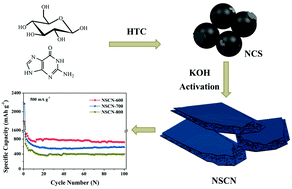Carbon materials such as graphite have been used as anode material for Li-ion batteries (LIBs). However, the energy stored in carbon materials is greatly dependent on their structural characteristics. Herein, nitrogen-rich sandwich-like carbon nanosheets (NSCN) have been prepared through a facile hydrothermal carbonization (HTC) method followed by pyrolysis. The nitrogen-rich sandwich-like carbon nanosheets synthesized at 600 °C (NSCN-600) have a higher specific surface area of 1112 m2 g−1 and a total nitrogen content of 11.4 wt% (therein 9.30 wt% for both pyridinic-N and pyrrolic-N), giving rise to high discharge capacity (910 mA h g−1 at 100 mA g−1 after 50 cycles) and remarkable rate capability (719 mA h g−1 at 500 mA g−1 after 200 cycles and 390 mA h g−1 at 2000 mA g−1). Such desirable electrochemical properties could be attributed to the unique sandwich-like nanostructures consisting of a number of amorphous carbon nanoparticles closely covered with carbon sheet layers. Such a simple preparation method could provide a strategy for rational engineering of nanostructured nitrogen-rich carbonaceous materials for high-performance LIBs.
